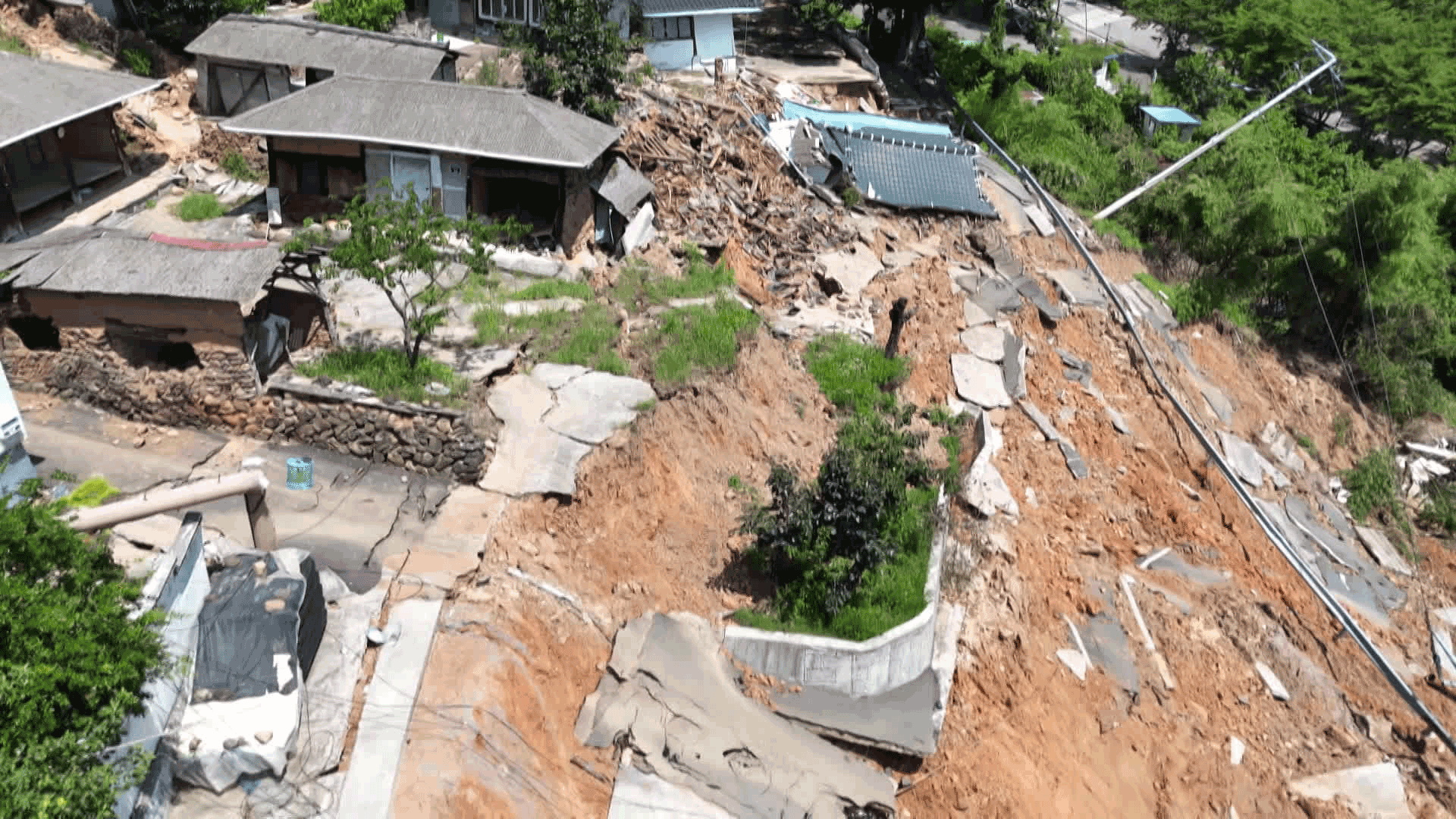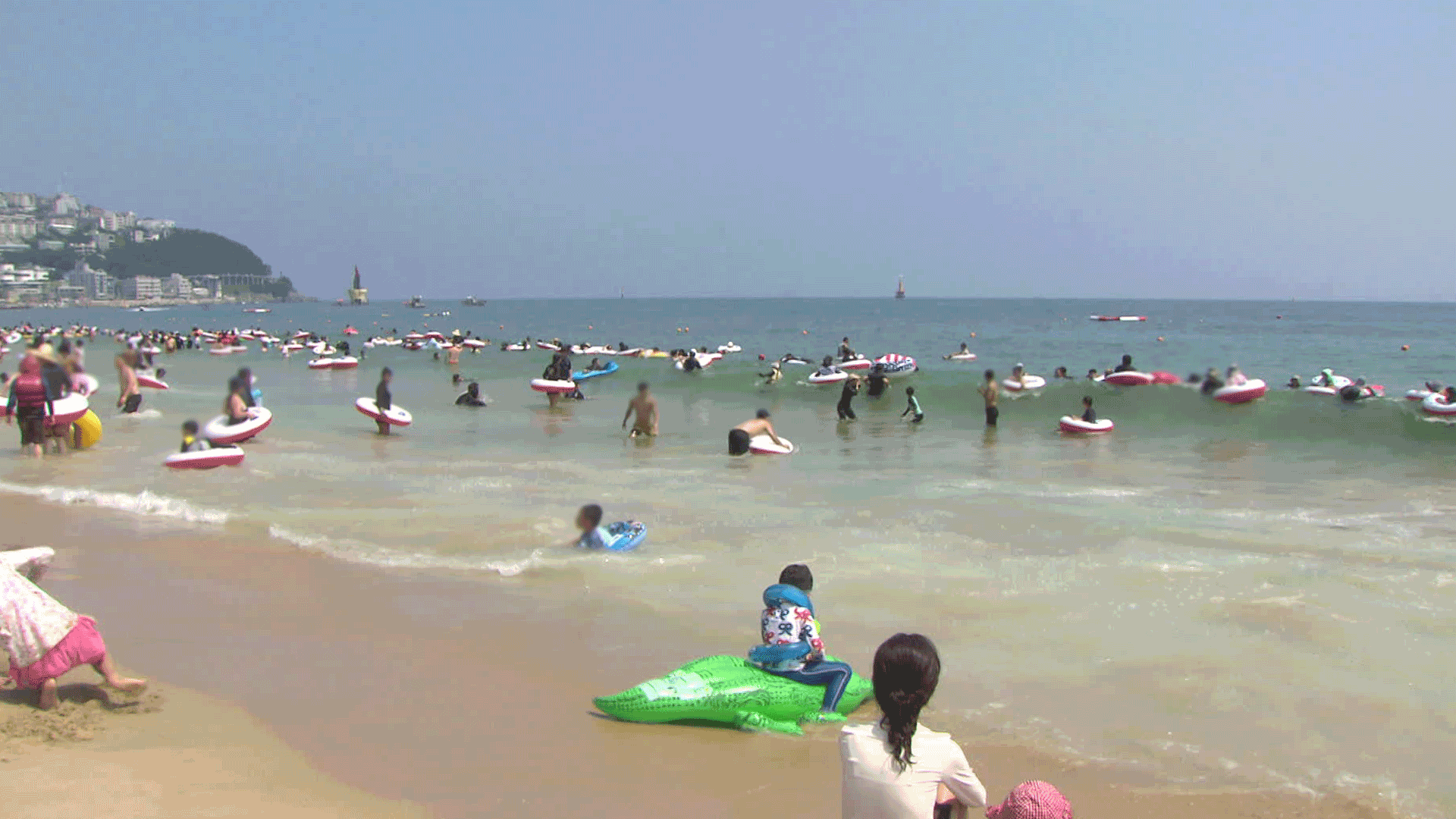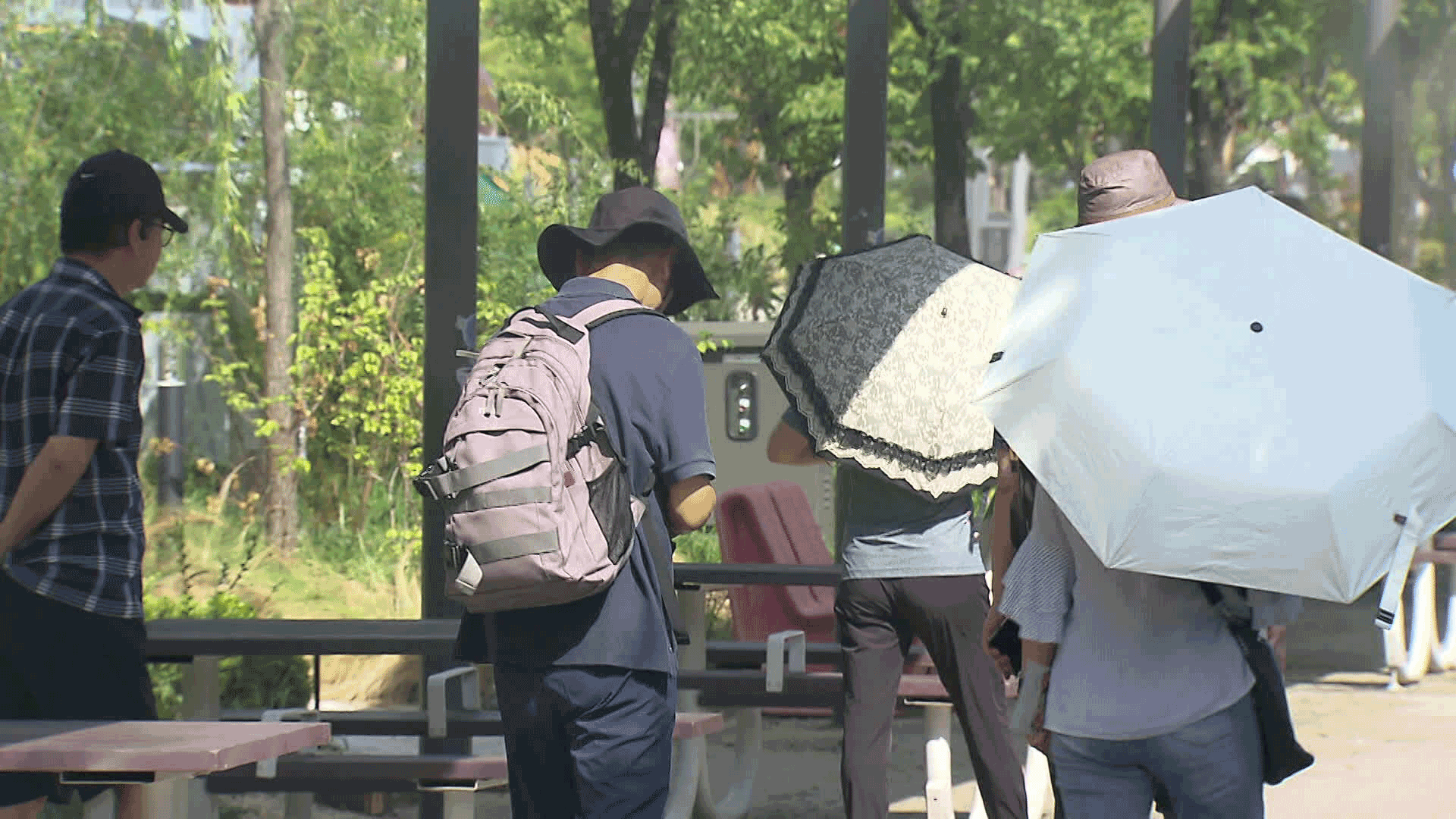[Anchor]
There is a village that decided to evacuate completely after the last heavy rain caused the entire village to nearly collapse.
Initially, it was thought to be a landslide, but analysis has shown that a much larger phenomenon called 'ladn creep' was the cause.
Reporter Kim So-young has the story.
[Report]
The village looks as if it has been bombed, with the ground sinking significantly.
Houses buried under red soil are barely visible, with only their roofs showing.
The ground has heaved up in various places as if an earthquake occurred, and the retaining walls of the houses are cracked wide open.
Utility poles have toppled to one side.
This situation is quite different from a typical landslide where soil and debris flow down a steep slope.
[Hong Hyuk-ki/Village Resident: "It maintains its shape and just slides down. While doing so, the ground was supported by the retaining wall next to it, but that cracked in the middle and started to push forward."]
Due to the severity of the damage, all 13 households in this village have decided to relocate collectively.
Experts who investigated the site suspect that the phenomenon of 'land creep' is the cause.
As you can see, the road has been cut off, and the soil layer itself has completely sunk by nearly 20 meters.
'Land creep' typically occurs on gentle slopes where the entire ground moves like a slide, causing much greater damage than landslides and a higher likelihood of recurrence.
The Korea Forest Service manages 'land creep' risk areas by classification, but this village was not included in the risk areas.
This is because the target areas are limited to 'mountainous' regions.
[Jeong Kyo-cheol/Emeritus Professor, Gyeongkuk National University, Department of Earth and Environmental Sciences: "(The village where land creep occurred) is not classified as mountainous or hilly. It is designated as residential and agricultural land. Even if it is farmland, if it is adjacent to mountainous areas, there should be disaster response measures."]
The Korea Forest Service plans to investigate the soil quality and causes in the village where land creep occurred.
This is KBS News, Kim So-young.
There is a village that decided to evacuate completely after the last heavy rain caused the entire village to nearly collapse.
Initially, it was thought to be a landslide, but analysis has shown that a much larger phenomenon called 'ladn creep' was the cause.
Reporter Kim So-young has the story.
[Report]
The village looks as if it has been bombed, with the ground sinking significantly.
Houses buried under red soil are barely visible, with only their roofs showing.
The ground has heaved up in various places as if an earthquake occurred, and the retaining walls of the houses are cracked wide open.
Utility poles have toppled to one side.
This situation is quite different from a typical landslide where soil and debris flow down a steep slope.
[Hong Hyuk-ki/Village Resident: "It maintains its shape and just slides down. While doing so, the ground was supported by the retaining wall next to it, but that cracked in the middle and started to push forward."]
Due to the severity of the damage, all 13 households in this village have decided to relocate collectively.
Experts who investigated the site suspect that the phenomenon of 'land creep' is the cause.
As you can see, the road has been cut off, and the soil layer itself has completely sunk by nearly 20 meters.
'Land creep' typically occurs on gentle slopes where the entire ground moves like a slide, causing much greater damage than landslides and a higher likelihood of recurrence.
The Korea Forest Service manages 'land creep' risk areas by classification, but this village was not included in the risk areas.
This is because the target areas are limited to 'mountainous' regions.
[Jeong Kyo-cheol/Emeritus Professor, Gyeongkuk National University, Department of Earth and Environmental Sciences: "(The village where land creep occurred) is not classified as mountainous or hilly. It is designated as residential and agricultural land. Even if it is farmland, if it is adjacent to mountainous areas, there should be disaster response measures."]
The Korea Forest Service plans to investigate the soil quality and causes in the village where land creep occurred.
This is KBS News, Kim So-young.
■ 제보하기
▷ 카카오톡 : 'KBS제보' 검색, 채널 추가
▷ 전화 : 02-781-1234, 4444
▷ 이메일 : kbs1234@kbs.co.kr
▷ 유튜브, 네이버, 카카오에서도 KBS뉴스를 구독해주세요!
- Land creep forces evacuation
-
- 입력 2025-08-02 03:36:30

[Anchor]
There is a village that decided to evacuate completely after the last heavy rain caused the entire village to nearly collapse.
Initially, it was thought to be a landslide, but analysis has shown that a much larger phenomenon called 'ladn creep' was the cause.
Reporter Kim So-young has the story.
[Report]
The village looks as if it has been bombed, with the ground sinking significantly.
Houses buried under red soil are barely visible, with only their roofs showing.
The ground has heaved up in various places as if an earthquake occurred, and the retaining walls of the houses are cracked wide open.
Utility poles have toppled to one side.
This situation is quite different from a typical landslide where soil and debris flow down a steep slope.
[Hong Hyuk-ki/Village Resident: "It maintains its shape and just slides down. While doing so, the ground was supported by the retaining wall next to it, but that cracked in the middle and started to push forward."]
Due to the severity of the damage, all 13 households in this village have decided to relocate collectively.
Experts who investigated the site suspect that the phenomenon of 'land creep' is the cause.
As you can see, the road has been cut off, and the soil layer itself has completely sunk by nearly 20 meters.
'Land creep' typically occurs on gentle slopes where the entire ground moves like a slide, causing much greater damage than landslides and a higher likelihood of recurrence.
The Korea Forest Service manages 'land creep' risk areas by classification, but this village was not included in the risk areas.
This is because the target areas are limited to 'mountainous' regions.
[Jeong Kyo-cheol/Emeritus Professor, Gyeongkuk National University, Department of Earth and Environmental Sciences: "(The village where land creep occurred) is not classified as mountainous or hilly. It is designated as residential and agricultural land. Even if it is farmland, if it is adjacent to mountainous areas, there should be disaster response measures."]
The Korea Forest Service plans to investigate the soil quality and causes in the village where land creep occurred.
This is KBS News, Kim So-young.
There is a village that decided to evacuate completely after the last heavy rain caused the entire village to nearly collapse.
Initially, it was thought to be a landslide, but analysis has shown that a much larger phenomenon called 'ladn creep' was the cause.
Reporter Kim So-young has the story.
[Report]
The village looks as if it has been bombed, with the ground sinking significantly.
Houses buried under red soil are barely visible, with only their roofs showing.
The ground has heaved up in various places as if an earthquake occurred, and the retaining walls of the houses are cracked wide open.
Utility poles have toppled to one side.
This situation is quite different from a typical landslide where soil and debris flow down a steep slope.
[Hong Hyuk-ki/Village Resident: "It maintains its shape and just slides down. While doing so, the ground was supported by the retaining wall next to it, but that cracked in the middle and started to push forward."]
Due to the severity of the damage, all 13 households in this village have decided to relocate collectively.
Experts who investigated the site suspect that the phenomenon of 'land creep' is the cause.
As you can see, the road has been cut off, and the soil layer itself has completely sunk by nearly 20 meters.
'Land creep' typically occurs on gentle slopes where the entire ground moves like a slide, causing much greater damage than landslides and a higher likelihood of recurrence.
The Korea Forest Service manages 'land creep' risk areas by classification, but this village was not included in the risk areas.
This is because the target areas are limited to 'mountainous' regions.
[Jeong Kyo-cheol/Emeritus Professor, Gyeongkuk National University, Department of Earth and Environmental Sciences: "(The village where land creep occurred) is not classified as mountainous or hilly. It is designated as residential and agricultural land. Even if it is farmland, if it is adjacent to mountainous areas, there should be disaster response measures."]
The Korea Forest Service plans to investigate the soil quality and causes in the village where land creep occurred.
This is KBS News, Kim So-young.
-
-

김소영 기자 kantapia@kbs.co.kr
김소영 기자의 기사 모음
-
이 기사가 좋으셨다면
-
좋아요
0
-
응원해요
0
-
후속 원해요
0















이 기사에 대한 의견을 남겨주세요.